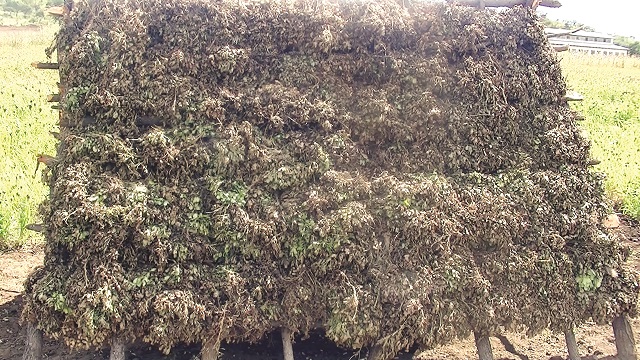Growing of legumes: killing 2 birds with one stone

Pamenus Tuso
AS agricultural scientists push for the growing of legumes and in particular groundnuts in semi-arid regions, they are killing two birds with one stone; encouraging the growing of drought tolerant crops as well as mitigating the effects of climate change.
But how does the growing of groundnuts and other legumes mitigate the effects of climate change?
Groundnuts are an effective component of semi-arid farming systems supporting nutrient recycling and soil carbon enrichment, a vital component in the reduction of green-house gas emissions hence mitigation against climate change, according to Dr Martin Moyo, a consultant scientist with the International Crop Research Institute for the Semi-Arid Tropics (ICRISAT).
“Soil nutrient recycling by growing groundnuts results in improved productivity from existing land rather than necessitating groundnuts resulting in improved expansion of land areas under cultivation, which is necessary in dealing with climate variability and change especially in semi-arid environments. Groundnuts haulms are also used as livestock feed, part of the promotion of integrated crop –livestock systems which help in establishing carbon-neutral production,” explained Dr Moyo.
Despite groundnuts being a critical component in the reduction of green-house gas emissions as well as the crop being one of the major sources of energy and protein respectively in many communities in the country, most legumes throughout the country have been affected by aflatoxins.
Aflatoxins are toxic secondary metabolites produced by two related fungi, aspegillus flavus and aspegillus paraciticus on agricultural products particularly maize and groundnuts.
“Aflatoxin is a poisonous substance produced by mould fungi that can grow on poorly managed agricultural crops particularly groundnuts. If eaten in sufficient quantities, aflatoxin can cause serious sickness that can lead to liver and several other cancers,” said Dr Moyo.
In poultry and livestock, he said, the diseases can cause feed refusal, loss of weight, reduced egg production and milk contamination.
Dr Moyo said Zimbabwe is one of the leading countries with high cases of aflatoxin contamination due to lack of awareness, particularly by smallholder farmers and small-scale traders and processors.
He said aflatoxin contamination is proving to be a major barrier in linking local farmers to lucrative regional and international markets as the disease prevents commodities from meeting international, regional and local regulations and standards governing agricultural trade and food safety.
“Both producers and processors in Zimbabwe have limited access to information on commodity access and quality, leaving some industries opting for the grain imports from neighbouring countries. Generally for the world markets, groundnuts for sale and export should be free from aflatoxin,” said the expert.
ICRISAT through the assistance of the Food and Agriculture Organisation has embarked on aflatoxins management and awareness programmes. Under these programmes, the consultant scientist revealed that his organisation has intensified its research about aflatoxin management in the country.
“ICRISAT notes that there is need for controlling aflatoxin contamination, but detection methods commonly used are expensive, complex and time consuming for the majority of smallholder groundnut producers. We are mainly focusing on appropriate crop management being essential at pre and post-harvest times. We are encouraging that groundnuts should be grown on ridges and that farmers should dry the crop on improved structures as the A-frame,” Dr Moyo said.
Aflatoxin contamination thrives on drought accompanied with high soil temperatures during pod growth, storage of cereals and grains that are not properly dried as well as infestation of pest and diseases on agricultural products.
ICRISAT has also introduced simple test kits that can be used by smallholder farmers as well as creating awareness to the farmers.
As part of the awareness campaign, ICRISAT in conjunction with Agritex recently held an open day at the research centre in Matopos where about 300 farmers from 13 districts of Matabeleland North and South provinces were taken through the production and treatment methods of groundnuts. The farmers were also taught how to test for aflatoxins in their crops
Ms Maureen Ndlovu, a farmer from Bubi District in Matabeleland North province described the open day as an eye opener.
“We grow groundnuts in Bubi but we did not know anything about the disease that affects the crop. We are glad that we have been taught how to prevent contamination of our groundnut crop and we are being offered test kits to detect the aflatoxins,” she said.
Ms Ndlovu said before attending the open day, she did not appreciate the importance of groundnuts in mitigating the effects of climate change.
“I think the effects of climate change have affected women mostly than men. As a woman, I am gladly prepared to be involved in any project or programmes which mitigate against climate change. So from now onwards, I will increase my groundnuts cultivation,” said Ms Ndlovu.
Acting principal director in the Department of Research Special Services in the Ministry of Agriculture, Mechanisation and Irrigation Development, Mr Blessing Mawoyo, said the research unit is currently conducting a survey to ascertain the prevalence of aflatoxins in groundnut producing areas around Zimbabwe.
“Areas covered so far include Mashonaland Central, Mashonaland East, Masvingo and some parts of the Midlands province.
“The survey is continuing until all the ten provinces are covered, hence we cannot pre-empt the preliminary findings,” said Mr Mawoyo.
He said the survey will help in mapping out areas that have high contamination levels of aflatoxins, thereby helping the department in carrying out awareness campaigns and train farmers on ways to prevent aflatoxin occurrence.
Mr Mawoyo said the research department is also working with various stakeholders such as fertiliser, farm feeds manufacturing companies as well as remedies institute in the screening of aflatoxins in all agricultural produce (raw and processed) through laboratory analysis.
He added that the department together with Agritex officers had so far managed to carry out awareness campaigns in areas such as Gokwe where farmers were being informed about ways of reducing and preventing aflatoxin contamination as well as the impact they have on trade and human health.











Comments